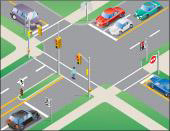Intersection Pedestrian Signal (“Half Signal”)
At an intersection pedestrian signal, a signal-protected crosswalk is provided across the major street. Traffic on the major street is controlled by signal heads and traffic on the minor street is controlled by stop signs.

Figure 1: Intersection Pedestrian Signal (source: MTO)
The Ontario Traffic Manual provides a warrant system to identify where traffic signals should and should not be provided. For pedestrian signals, the warrant has two parts; both parts of the warrant must be met for the warrant to be met overall. The warrant review results are summarized in Table 3.
Table 2: Pedestrian Signal Warrant Review Summary
| Warrant Part | Result |
|---|---|
| 1 – Minimum Pedestrian Crossing Volume | Not met |
| 2 – Delay to Pedestrians | Not met |
| Overall | Warrant not met |
Highway Traffic Act
While the Ontario Traffic Manual guidelines suggest that neither a pedestrian crossover nor a pedestrian signal be provided at this location, neither option would contravene the Highway Traffic Act.
Risk Analysis:
For Cabana Road East at Karen Street/Clara Avenue, neither a pedestrian crossover nor a pedestrian signal would be in keeping with provincial guidelines set out in the Ontario Traffic Manual.
Administration uses established guidelines as a risk management tool, since following these guidelines can help limit risk to the Corporation and to others. Departing from established guidelines may result in higher safety risks to road users and higher risks of claims against the Corporation.